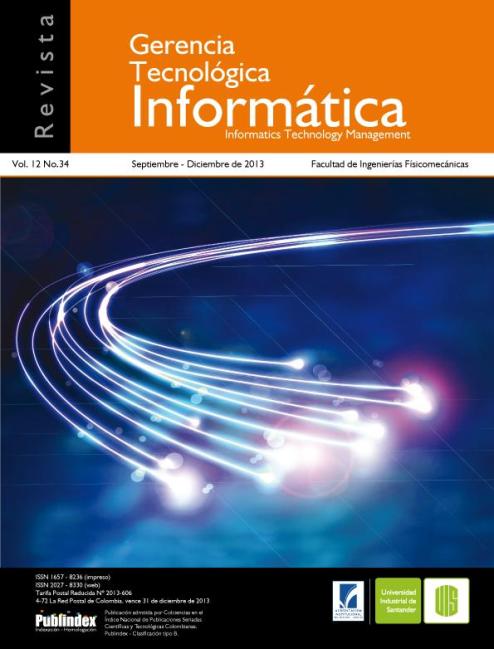Publicado 2014-02-27
Cómo citar
Resumen
RESUMEN ANALÍTICO
La ingeniería de software busca defnir procesos, controlarlos y seguirlos con el fn de construir productos de calidad que garanticen al usuario su satisfacción, generalmente medida en términos de funcionalidad del producto, pero pocas veces evaluada en términos de usabilidad del mismo. Este artículo presenta un modelo para el ciclo de vida de desarrollo de software, basado en la metodología Human-Centered Design (HCD) en el cual son integrados algunos métodos utilizados en el diseño de producto (diseño industrial). Este modelo incluye métodos de usabilidad (efciencia, efcacia y satisfacción) y técnicas para el diseño de interfaces gráfcas de usuario (apreciación y estética). La investigación utilizó una metodología de análisis cualitativo a través del análisis de la experiencia de una PYME de desarrollo de software. Por último, se utilizó el modelo de referencia Capability and Maturity Model Integrated (CMMI) para la validación del modelo propuesto.
PALABRAS CLAVES: Usabilidad, Diseño Centrato en el Usuario, Diseño como Proceso, Ciclo de Vida del Producto.
METHODOLOGICAL APPROACH FOR INTERFACE DESIGN DURING SOFTWARE DEVELOPMENT LIFE-CYCLE
ANALYTICAL SUMMARY
Software engineering looks for defning, controlling and following processes, it aiming to construct high quality products in order to guarantee user satisfaction. Usually, it is measured in functionality terms, but few times measured from the perspective of usability. This paper presents a life cycle model of software development, based on the Human Centered Design (HCD) methodology, which integrates some methods used in product design (industrial design). The model includes usability methods (effciency, effcacy and satisfaction) and techniques for graphic user interfaces (aesthetic and visual perception). The research uses an analytic qualitative methodology approach by the experience of a SME (Small and Medium Enterprises) of software development. Finally, Capability and Maturity Model Integrated (CMMI) was used as reference for validating the model.
KEYWORDS: Usability, Human-Centered Design, design as process, product life cycle.
Descargas
Referencias
- Antonelli, P., & Museum of Modern Art (2011), Talk to me : design and the communication between people and objects, New York: Museum of Modern Art 207 p.
- ISO, ISO 9241-11 (1998) Ergonomics of humansystem interaction- Guidance on usability, International Standard Organization.
- IEEE Xplore (2012), International Workshop on Usability and Accessibility Focused Requirements Engineering UsARE, IEEE,: Piscataway, N.J.
- Vilbergsdottir, S. et al. (2014), Assessing the reliability, validity and acceptance of a classification scheme of usability problems (CUP). Journal of Systems and Software. 87(0): p. 18-37.
- Albers, M., & Still B. (2011), Usability of complex information systems evaluation of user interaction, CRC Press,: Boca Raton, FL. p. 1 online resource (xxvii, 371 p.).
- Martinez, J, et al. (2013), El rol del diseñador en el desarrollo de software. Revista Arquetipo, 5: p. 7-16.
- Jaspers, M. et al. (2005), The think aloud method: a guide to user interface design. International Journal of Medical Informatics. 73(11–12): p. 781- 795.
- Sutcliffe, A. et al. (2006), A method and advisor tool for multimedia user interface design. International Journal of Human-Computer Studies. 64(4): p. 375-392.
- Shneiderman, B., & Plaisant, C. (2009), Designing the User Interface: Strategies for Effective HumanComputer Interaction. Addison-Wesley ed. Vol. 5 edition. 2009: Prentice Hall. 624.
- Molina, A., & Giraldo W. et al. (2012), CIAT-GUI: A MDE-compliant environment for developing Graphical User Interfaces of information systems. Advances in Engineering Software, 2012. 52(0): p. 10-29.
- Calinescu, R. et al. (2010), Foundations of computer software modeling, development, and verification of adaptive systems, 16th Monterey Workshop 2010, Springer: Berlin; Heidelberg; New York. p. xii, 238 p.
- Poelman, W. et al. (2008), Design processes what architects & industrial designers can teach each other about managing the design process, 2008, IOS Press: Amsterdam 122 p.
- Mayhew, D. (2005), Cost-justifying usability an update for internet age. Books 24x7 Inc. EEUU.
- IDEO. (2011), Human-Centered Design Toolkit: An Open-Source Toolkit To Inspire New Solutions in the Developing World. 3th. Edition ed: IDEO.
- Nemeth, C. (2004) , Human factors methods for design : making systems human-centered, Boca Raton: CRC Press. xxiii, 392 p.
- Cross, N. (2011), Design Thinking: Understanding How Designers Think and Work, Bloomsbury Academic, 192 p.
- Acuña, S. et al. (2012) A HCI technique for improving requirements elicitation. Information and Software Technology, 54 (12), 1357-1357.
- Otto, K. et al. (2001), Product design: techniques in reverse engineering and new product development, Upper Saddle River, NJ: Prentice Hall. xxi, 1071 p.
- Chrissis, M. et al. (2011), CMMI for Development: Guidelines for Process Integration and Product Improvement. 3rd Edition: SEI Series in Software Engineering.
- Marcus, A. (2011), Design, user experience, and usability theory, methods, tools and practice: first International Conference, HCI International, Orlando, FL, USA, proceedings. Part I, in Lecture notes in computer science 67692011, Springer,: Berlin ; New York. p. xxxi, 718 p.
- Nielsen, J. et al. (1995), Usability inspection methods, New York: John Wiley & Sons. xxiv, 413 p.
- Salvendy, G. (2012), Handbook of Human Factors and Ergonomics. 4 edition ed: Wiley.
- Kan, S. et al. (2002), Metrics and models in software quality engineering: Addison-Wesley Longman Publishing Co., Inc.
- Harrington, J. et al. (1997), Business process improvement workbook: documentation, analysis, design, and management of business process improvement, New York: McGraw-Hill. xix, 314 p.
- López, C, et al. (2002), Aplicación Del Proceso Unificado De Desarrollo De Software A Nivel Local. Revista Gerencia Tecnológica Informática, 2002. 1(1).
- LLamosa, R. & Estrada L. (2010), Aprendizaje y aplicación del modelo CMMI - DEV en Pymes de software colombianas. La experiencia RCCS. Revista Gerencia Tecnológica Informática, 2010. Vol. 9(24): p. 57 - 76.
